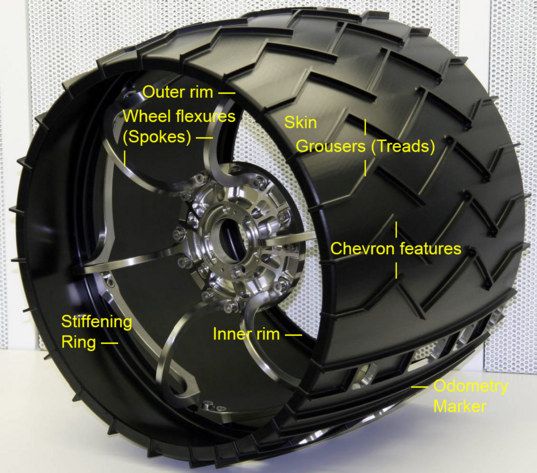Lakdawalla has a thorough (but easy to understand) writeup on Curiosity’s wheels, including an explanation of what “strongly cemented ventifacts” are, how the wheels and the rover’s suspension system work, and what lessons this incident has for the next rover mission, scheduled for 2020.There were several factors that drove them to design the wheels to be as lightweight as possible. The large size of the wheels means that very slight design changes add a substantial amount of mass. Increasing wheel thickness by one millimeter would add 10 kilograms to the rover's total mass. But total system mass wasn't the only constraint. Erickson explained that a major constraint arose from a tricky moment in the landing sequence, at the moment that the wheels deployed, while the rover was suspended from the bridle underneath the descent stage. The wheels' sudden drop imparted substantial forces on the mobility system, and keeping wheel mass as light as possible reduced those forces to manageable ones. There were other factors that made it important to keep wheel mass low.
So the wheels needed to be as light as possible while still being able to do their job, but as to their job: "We misunderstood what Mars was," Erickson said. "Strongly cemented ventifacts are not something that we saw on Mars before."
Welcome to ...
The place where the world comes together in honesty and mirth.
Windmills Tilted, Scared Cows Butchered, Lies Skewered on the Lance of Reality ... or something to that effect.
Windmills Tilted, Scared Cows Butchered, Lies Skewered on the Lance of Reality ... or something to that effect.
Wednesday, January 7, 2015
Martian Wheel Damage
The
Mars Curiosity rover has been exploring the surface of the red planet
for two and half years now, and it shows. The rover’s wheels are
displaying severe damage, developing holes and tears due to the rough
Martian rocks. NASA officials didn’t seem to be concerned at first, but
now they are. Emily Lakdawalla of The Planetary Society wanted to find
out exactly what’s happening to the wheels and how it will affect
Curiosity’s mission, so she talked to Project Manager Jim Erickson to
get the lowdown. Why weren’t the wheels designed for such rough terrain?
Subscribe to:
Post Comments (Atom)


No comments:
Post a Comment